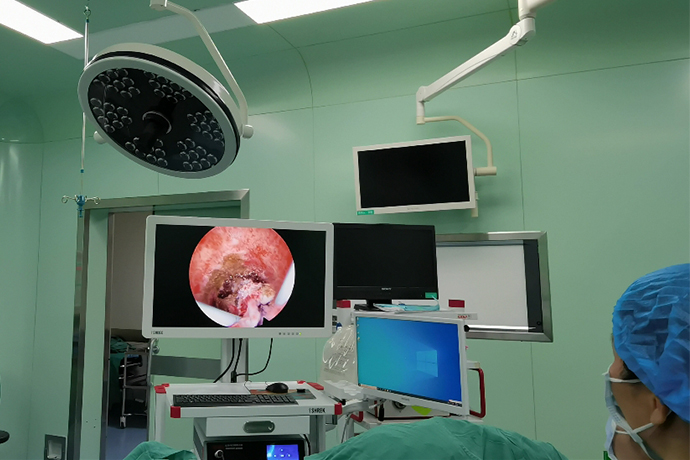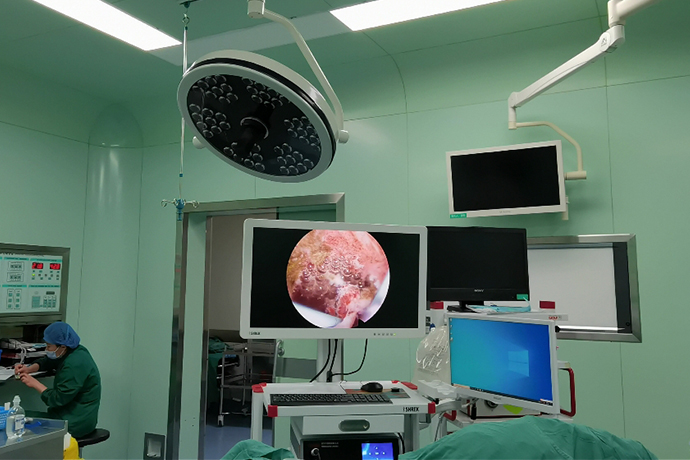【Hysteroscopy】Surgery Steps of Hysteroscopy for Intrauterine Adhesions
Release time: 26 Apr 2021 Author:Shrek
Guide
Uterine adhesions (IUA), also known as Asheman syndrome, is caused by trauma to the uterine uterus during pregnancy or non-pregnancy, resulting in damage to the basal layer of the endometrium, partially or completely occlusion of the uterine cavity, leading to abnormal menstruation, infertility, or repeated miscarriage. Its essence is intimal fibrosis.
What this article is sharing today is the procedure of hysteroscopic hysterectomy and scissors separation.

01 Surgery steps of hysteroscopic hysterectomy
(1) Fill the bladder, place the probe carefully under the guidance of B-mode ultrasound, and use Hegar to dilate the cervix and uterine cavity one by one. If the probe is unable to reach the bottom of the uterus or only penetrate the cervical canal in patients with locked uterine cavity, it can be opened later by hysteroscopic surgery, or under the supervision of B-mode ultrasound, the probe can be vigorously probed along the cervix and the midline of the uterus bottom of the palace.
(2) Under the guidance of B ultrasound, insert the hysteroscope into the uterine cavity along the external cervix and cervical canal. Check the morphology of the cervical canal and uterine cavity, observe the double measurement of the uterine angle and the opening of the fallopian tube, reveal the adhesion tissue, and clarify the location and degree of adhesion.
(3) Use hysteroscopic resectoscope needle electrodes or ring electrodes to remove the dense adhesion scar tissue in the cervical canal.
(4) Central membranous or fibrous adhesion tissues in the uterine cavity can be cut with hysteroscope needle electrodes or resection with ring electrodes. The normal endometrium needs to be protected during the operation.
(5) For the adhesion scar tissue on the anterior, posterior and side walls of the uterine cavity, a needle electrode can be used to cut along the long axis of the uterus, and if necessary, use a ring electrode to remove.
(6) The adhesion of the fundus and the corners of the uterus needs to be cut horizontally with a needle electrode or cut horizontally with a ring electrode to fully open the fundus. At the same time, the cutting moves toward the corners of the uterus, and try to open the uterine corners on both sides to expose the oviduct opening. Generally, under B-mode ultrasound monitoring, a needle electrode is used to separate the adhesions at the common corners, and if necessary, a ring electrode is used to cut the adhesions to gradually expose the uterine horns and fallopian tube openings, and restore the normal shape of the bilateral uterine horns. Attention should be paid to protecting the normal endometrial tissue at the corner of the uterus.
(7) For patients with uterine cavity constriction caused by scar spasm on the uterine wall, needle electrodes can be used to cut 4 to 5 scar tissues radially along the long axis of the uterus to enlarge the uterine cavity volume.
(8) If the uterine cavity is closed and the front of the scope is blind, under the monitoring of B-mode ultrasound, use needle electrodes or ring electrodes along the midline of the cervix and uterus to energize and push forward to try to open the adhesive tissue and cut out the pores reveal the uterine cavity. Then follow the above steps to remove the uterine cavity adhesions and restore the normal uterine cavity shape.
(9) At the end of the operation, retract the objective lens to the internal cervix to observe the shape and symmetry of the uterine cavity
(10) For those who have laparoscopic monitoring, methylene blue solution can be injected into the uterine cavity to test the patency of the fallopian tube, and observe the patency of the fallopian tube under laparoscopy.
02 Uterine adhesion hysteroscopy scissors separation method
(1) Hysteroscopy first. Place the hysteroscopic resectoscope, and check the uterine cavity shape and uterine adhesions under direct vision.
(2) The bendable semi-rigid scissors or hard scissors are delivered to the uterine cavity along the operating channel of the hysteroscope.
(3) Use hysteroscopic scissors to gradually separate the adhesions from the center of the uterine cavity to the surroundings to enlarge the uterine cavity. If the adhesion is extensive, pay attention to the depth of the adhesion and separation, and be alert to the occurrence of uterine perforation. When separated to the bus station, try to free the uterine horns under the guidance of B-mode ultrasound to expose the fallopian tube opening.
(4) When the uterine cavity or cervical canal is completely atresia, start from below the adhesion, and gradually separate along the midline of the uterus under the guidance of B-mode ultrasound until a new uterine cavity is opened.

Uterine adhesions (IUA), also known as Asheman syndrome, is caused by trauma to the uterine uterus during pregnancy or non-pregnancy, resulting in damage to the basal layer of the endometrium, partially or completely occlusion of the uterine cavity, leading to abnormal menstruation, infertility, or repeated miscarriage. Its essence is intimal fibrosis.
What this article is sharing today is the procedure of hysteroscopic hysterectomy and scissors separation.

01 Surgery steps of hysteroscopic hysterectomy
(1) Fill the bladder, place the probe carefully under the guidance of B-mode ultrasound, and use Hegar to dilate the cervix and uterine cavity one by one. If the probe is unable to reach the bottom of the uterus or only penetrate the cervical canal in patients with locked uterine cavity, it can be opened later by hysteroscopic surgery, or under the supervision of B-mode ultrasound, the probe can be vigorously probed along the cervix and the midline of the uterus bottom of the palace.
(2) Under the guidance of B ultrasound, insert the hysteroscope into the uterine cavity along the external cervix and cervical canal. Check the morphology of the cervical canal and uterine cavity, observe the double measurement of the uterine angle and the opening of the fallopian tube, reveal the adhesion tissue, and clarify the location and degree of adhesion.
(3) Use hysteroscopic resectoscope needle electrodes or ring electrodes to remove the dense adhesion scar tissue in the cervical canal.
(4) Central membranous or fibrous adhesion tissues in the uterine cavity can be cut with hysteroscope needle electrodes or resection with ring electrodes. The normal endometrium needs to be protected during the operation.
(5) For the adhesion scar tissue on the anterior, posterior and side walls of the uterine cavity, a needle electrode can be used to cut along the long axis of the uterus, and if necessary, use a ring electrode to remove.
(6) The adhesion of the fundus and the corners of the uterus needs to be cut horizontally with a needle electrode or cut horizontally with a ring electrode to fully open the fundus. At the same time, the cutting moves toward the corners of the uterus, and try to open the uterine corners on both sides to expose the oviduct opening. Generally, under B-mode ultrasound monitoring, a needle electrode is used to separate the adhesions at the common corners, and if necessary, a ring electrode is used to cut the adhesions to gradually expose the uterine horns and fallopian tube openings, and restore the normal shape of the bilateral uterine horns. Attention should be paid to protecting the normal endometrial tissue at the corner of the uterus.
(7) For patients with uterine cavity constriction caused by scar spasm on the uterine wall, needle electrodes can be used to cut 4 to 5 scar tissues radially along the long axis of the uterus to enlarge the uterine cavity volume.
(8) If the uterine cavity is closed and the front of the scope is blind, under the monitoring of B-mode ultrasound, use needle electrodes or ring electrodes along the midline of the cervix and uterus to energize and push forward to try to open the adhesive tissue and cut out the pores reveal the uterine cavity. Then follow the above steps to remove the uterine cavity adhesions and restore the normal uterine cavity shape.
(9) At the end of the operation, retract the objective lens to the internal cervix to observe the shape and symmetry of the uterine cavity
(10) For those who have laparoscopic monitoring, methylene blue solution can be injected into the uterine cavity to test the patency of the fallopian tube, and observe the patency of the fallopian tube under laparoscopy.
02 Uterine adhesion hysteroscopy scissors separation method
(1) Hysteroscopy first. Place the hysteroscopic resectoscope, and check the uterine cavity shape and uterine adhesions under direct vision.
(2) The bendable semi-rigid scissors or hard scissors are delivered to the uterine cavity along the operating channel of the hysteroscope.
(3) Use hysteroscopic scissors to gradually separate the adhesions from the center of the uterine cavity to the surroundings to enlarge the uterine cavity. If the adhesion is extensive, pay attention to the depth of the adhesion and separation, and be alert to the occurrence of uterine perforation. When separated to the bus station, try to free the uterine horns under the guidance of B-mode ultrasound to expose the fallopian tube opening.
(4) When the uterine cavity or cervical canal is completely atresia, start from below the adhesion, and gradually separate along the midline of the uterus under the guidance of B-mode ultrasound until a new uterine cavity is opened.

- Recommended news
- 【General Surgery Laparoscopy】Cholecystectomy
- Surgery Steps of Hysteroscopy for Intrauterine Adhesion
- [Gynecological Hysteroscopy] Techniques for Preventing and Treating Complications of Hysteroscopic Surgery
- [Gynecological Hysteroscopy] Hysteroscopic Adhesiolysis
- [Gynecological Hysteroscopy] IUD Removal under Hysteroscopy